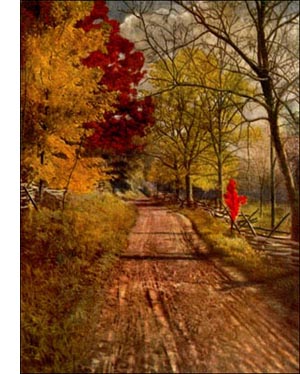Mockernut or Big Bud Hickory Tree
 Mockernut, Big Bud Hickory (Hicoria alba, Britt.)-A slender, tall, pyramidal tree, 50 to 80 feet high. Bark grey, thick, hard, close, rough, scaly; twigs pubescent, resinous, dotted. Wood dark brown (sap wood white), heavy, hard, strong, elastic, close. Buds: terminal ones large, ovate; outer scales ovate, acute, often keeled, falling in autumn; lateral buds small, yellowish brown. Leaves alternate, 15 to 20 inches long, of 7 to 9 leaflets, sessile, except end one, serrate, oblong-lanceolate, downy, yellowgreen, russet or yellow in fall; petiole downy, swollen, large. Flowers: staminate in catkins 4 to 8 inches long, hairy; pistillate 2 to 3 on terminal spike, May. Fruit, October, 1 to 3 nuts, globose or oblong, often long-pointed; 1 1/2 to 2 inches long, red-brown, strong scented; sutures opening to middle or nearly to base; nut globular, 4-ridged near top, thick shelled; kernel small, sweet, edible; often replaced by spongy mass. Preferred habitat, rich soil, on hillsides, North; near bogs and swamps South. Distribution, Ontario to Florida; west to Kansas and Texas. Uses: Lumber confused with shellbark hickory; nuts edible, but small, and very thick shelled. Tree planted for ornament and shade.
Mockernut, Big Bud Hickory (Hicoria alba, Britt.)-A slender, tall, pyramidal tree, 50 to 80 feet high. Bark grey, thick, hard, close, rough, scaly; twigs pubescent, resinous, dotted. Wood dark brown (sap wood white), heavy, hard, strong, elastic, close. Buds: terminal ones large, ovate; outer scales ovate, acute, often keeled, falling in autumn; lateral buds small, yellowish brown. Leaves alternate, 15 to 20 inches long, of 7 to 9 leaflets, sessile, except end one, serrate, oblong-lanceolate, downy, yellowgreen, russet or yellow in fall; petiole downy, swollen, large. Flowers: staminate in catkins 4 to 8 inches long, hairy; pistillate 2 to 3 on terminal spike, May. Fruit, October, 1 to 3 nuts, globose or oblong, often long-pointed; 1 1/2 to 2 inches long, red-brown, strong scented; sutures opening to middle or nearly to base; nut globular, 4-ridged near top, thick shelled; kernel small, sweet, edible; often replaced by spongy mass. Preferred habitat, rich soil, on hillsides, North; near bogs and swamps South. Distribution, Ontario to Florida; west to Kansas and Texas. Uses: Lumber confused with shellbark hickory; nuts edible, but small, and very thick shelled. Tree planted for ornament and shade.The mockernut has downy buds in winter-this alone will distinguish it from the two smooth-budded shellbarks, which have buds even larger than this species. The outer scales are almost black on the buds of H. ovata and H. laciniosa; on H. alba they are yellowish, for the darker outer scales fall early in autumn. The bark of the mockernut looks more like that of an ash than a hickory. It is broken by shallow fissures into intersecting ridges, and is coated with silvery scales. The branches are stout and curved, giving the tree in winter an expression of strength and grace.
The heart wood is dark brown, but the white sap wood largely predominates, to the advantage of the lumber. The elasticity of hickory wood is somewhat lost in the mature heart wood, so sap wood is best. For this reason second-growth hickory, which is almost all sap wood, is especially valuable. The names alba and white heart both refer to the colour of the sap wood.
The nut is truly a mockery to anyone who considers his thumbs. The husk is thick and stubbornly adherent at the base. The shell is almost invulnerable. When at last it is shattered by a blow, the kernel, though sweet, is small, and poorly repays the trouble. Oftentimes there is no kernel at all.
The mockernut is the commonest hickory tree in the South. It is believed to hybridise with the pecan, possibly with H. ovata and some varieties of H. glabra. The parentage of trees intermediate between one species and another can only be surmised; never proved. If artificial crossing produces duplicates of the questionable trees, then surmises may be considered well founded.